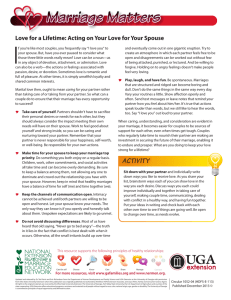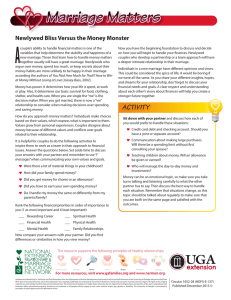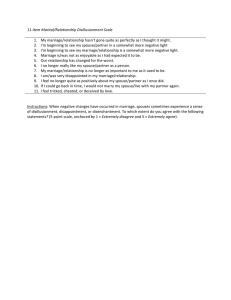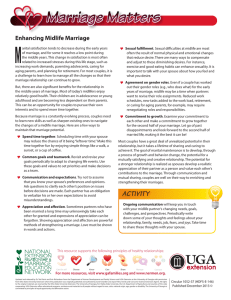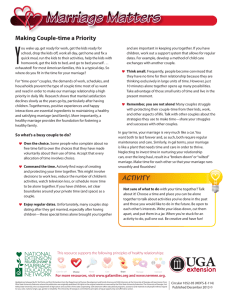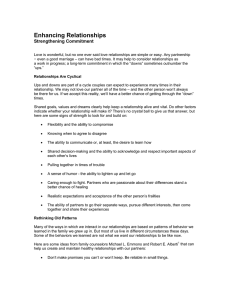E
advertisement
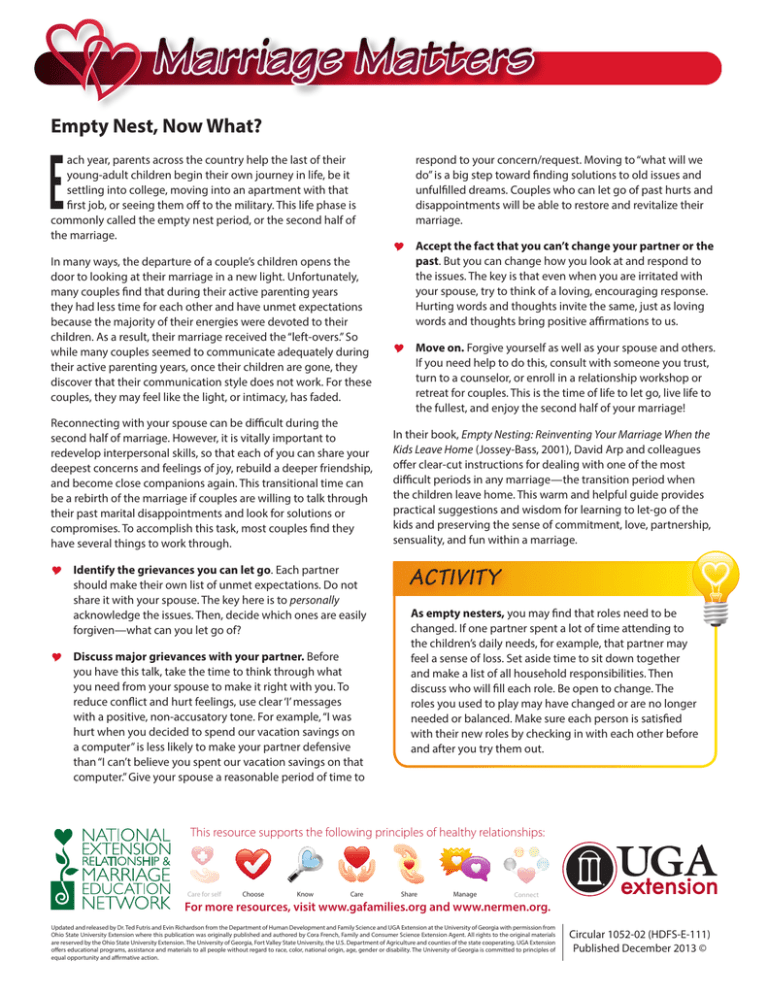
Empty Nest, Now What? E ach year, parents across the country help the last of their young-adult children begin their own journey in life, be it settling into college, moving into an apartment with that first job, or seeing them off to the military. This life phase is commonly called the empty nest period, or the second half of the marriage. In many ways, the departure of a couple’s children opens the door to looking at their marriage in a new light. Unfortunately, many couples find that during their active parenting years they had less time for each other and have unmet expectations because the majority of their energies were devoted to their children. As a result, their marriage received the “left-overs.” So while many couples seemed to communicate adequately during their active parenting years, once their children are gone, they discover that their communication style does not work. For these couples, they may feel like the light, or intimacy, has faded. Reconnecting with your spouse can be difficult during the second half of marriage. However, it is vitally important to redevelop interpersonal skills, so that each of you can share your deepest concerns and feelings of joy, rebuild a deeper friendship, and become close companions again. This transitional time can be a rebirth of the marriage if couples are willing to talk through their past marital disappointments and look for solutions or compromises. To accomplish this task, most couples find they have several things to work through. � Identify the grievances you can let go. Each partner should make their own list of unmet expectations. Do not share it with your spouse. The key here is to personally acknowledge the issues. Then, decide which ones are easily forgiven—what can you let go of? � Discuss major grievances with your partner. Before you have this talk, take the time to think through what you need from your spouse to make it right with you. To reduce conflict and hurt feelings, use clear ‘I’ messages with a positive, non-accusatory tone. For example, “I was hurt when you decided to spend our vacation savings on a computer” is less likely to make your partner defensive than “I can’t believe you spent our vacation savings on that computer.” Give your spouse a reasonable period of time to respond to your concern/request. Moving to “what will we do” is a big step toward finding solutions to old issues and unfulfilled dreams. Couples who can let go of past hurts and disappointments will be able to restore and revitalize their marriage. � Accept the fact that you can’t change your partner or the past. But you can change how you look at and respond to the issues. The key is that even when you are irritated with your spouse, try to think of a loving, encouraging response. Hurting words and thoughts invite the same, just as loving words and thoughts bring positive affirmations to us. � Move on. Forgive yourself as well as your spouse and others. If you need help to do this, consult with someone you trust, turn to a counselor, or enroll in a relationship workshop or retreat for couples. This is the time of life to let go, live life to the fullest, and enjoy the second half of your marriage! In their book, Empty Nesting: Reinventing Your Marriage When the Kids Leave Home (Jossey-Bass, 2001), David Arp and colleagues offer clear-cut instructions for dealing with one of the most difficult periods in any marriage—the transition period when the children leave home. This warm and helpful guide provides practical suggestions and wisdom for learning to let-go of the kids and preserving the sense of commitment, love, partnership, sensuality, and fun within a marriage. ACTIVITY As empty nesters, you may find that roles need to be changed. If one partner spent a lot of time attending to the children’s daily needs, for example, that partner may feel a sense of loss. Set aside time to sit down together and make a list of all household responsibilities. Then discuss who will fill each role. Be open to change. The roles you used to play may have changed or are no longer needed or balanced. Make sure each person is satisfied with their new roles by checking in with each other before and after you try them out. This resource supports the following principles of healthy relationships: Care for self Choose Know Care Share Manage Connect For more resources, visit www.gafamilies.org and www.nermen.org. Updated and released by Dr. Ted Futris and Evin Richardson from the Department of Human Development and Family Science and UGA Extension at the University of Georgia with permission from Ohio State University Extension where this publication was originally published and authored by Cora French, Family and Consumer Science Extension Agent. All rights to the original materials are reserved by the Ohio State University Extension. The University of Georgia, Fort Valley State University, the U.S. Department of Agriculture and counties of the state cooperating. UGA Extension offers educational programs, assistance and materials to all people without regard to race, color, national origin, age, gender or disability. The University of Georgia is committed to principles of equal opportunity and affirmative action. Circular 1052-02 (HDFS-E-111) Published December 2013 ©
